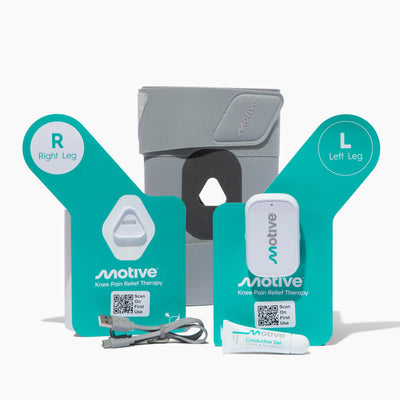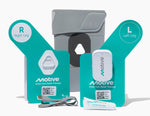
Did you know that knee pain can affect people of all age groups?
In older individuals above the age of 65, age-related issues such as knee osteoarthritis or weakened knee muscles and bones may contribute to knee pain. In younger individuals, knee pain can result from underlying medical conditions, sports-related knee injuries, or overuse of the knee joints.
Some other common causes of knee pain include ruptured ligaments, torn cartilage, bursitis, tendinitis, gout, pseudogout, rheumatoid arthritis, meniscus tear, sprains, or infections. However, a precise diagnosis can only be identified by a healthcare professional based on individual symptoms and medical history.
In this article, we will review immediate actions that you can take to manage knee pain, strategies that you can follow to get lasting pain relief, and medical treatments available to treat severe knee damage.
Immediate Actions for Knee Pain
RICE (rest, ice, compress, and elevate) is one of the most conventional and immediate approaches to managing knee joint pain. Here’s what it means:
Rest and Protect the Knee
Rest and avoid over stressing your knee by doing too much activity or lifting heavy weights. Straining your knee during mild pain can worsen your knee problems and increase your knee pain. Often, wearing knee braces or supports helps protect the knee and provide temporary comfort.
Apply Ice and Heat
Apply an ice pack in the affected area for 15-20 minutes every 3-4 hours. Before applying ice, cover your knee with a towel, and do not keep ice packs on for too long to avoid frostbite. Ice helps reduce swelling, redness, and knee pain in the affected area. If you have chronic knee pain without swelling, apply heat in the affected area for 15 minutes with a break of an hour in between uses. Hot saunas, showers, warm baths, steam baths, or the application of warm, damp towels help increase flexibility and stiffness by loosening tight muscles. Avoid putting heat directly on the knee, as this can cause burns, and stay hydrated when using saunas, baths and steam showers.
Elevate and Compress
Wrap the affected or swollen area using an elastic bandage. It helps reduce swelling and comfort your knee. However, make sure that you don’t wrap it too tightly, which can cause numbness, tingling, and increased pain in the affected area. It’s also recommended to elevate your knee above the level of your heart by keeping pillows beneath it before applying ice or any time you are lying down or sitting. This also helps in minimizing swelling of the knee.
Long-Term Strategies for Knee Pain Management
Mild knee pain can be managed on your own using some immediate methods, such as the RICE technique, or following some exercises or a healthy diet. These are effective in getting relief from knee pain without medications or treatments. However, it’s always advised to see an orthopedic surgeon to learn about the severity of your knee condition and receive recommended treatment options.
Strengthening Exercises
Physical therapy is a good way to keep your knee in good shape. It helps strengthen the quadriceps and hamstring muscles around the knee, providing more flexibility and mobility to your knee joint. Squats, standing hamstring curls, standing knee lifts, and inner thigh stretches are some exercises that can help manage knee pain.
However, consult a physical therapist to learn which exercises are more suitable to comfort your knee condition. Warm up before exercise and cool down after exercising to help relieve or prevent knee pain.
Weight Management
Obesity or excess weight increases strain on the knee, leading to knee pain and inflammation, and worsens the knee's health. That’s why keeping a healthy weight and maintaining a healthy diet helps manage knee pain by relieving the pressure on the knees. Any weight loss may help you get some comfort and decrease your knee pain.
Proper Footwear
Wearing comfortable footwear, such as flat, lightweight, and flexible shoes for walking, can help manage knee pain by absorbing shock and reducing stress on your knee. Additionally, using arch supports (orthotics) and custom shoe inserts can offer relief for those experiencing issues related to flat feet. Pointy shoes, high heels, and shoes with hard soles cause discomfort in walking and may increase knee problems or pain.
Medical Treatments and Interventions
Based on the severity of the knee problem, a range of non-invasive and surgical medical treatments are recommended by orthopedics to manage and treat knee pain. Treatment is given only after the correct diagnosis of the disease through physical examination or imaging tests such as X-ray, MRI, or ultrasound.
Medication
A range of over-the-counter and prescription medicines are available to manage knee pain. Some non-steroidal anti-inflammatory drugs (NSAIDs) used for knee pain include ibuprofen (Advil). Naproxen sodium (Aleve) and paracetamol (a painkiller) also provide temporary knee pain relief. Medicines like corticosteroids and opioid pain relievers require a prescription from the doctor for pain management.
Injections and Surgical Options
Some anti-inflammatory injections, such as corticosteroid or cortisone injections, also help manage knee swelling and pain. They are directly injected into the knee and are most commonly used to treat osteoarthritis. Hyaluronic acid injections also help in reducing knee pain by increasing lubrication and reducing friction between two bones. In severe cases of knee injuries, arthroscopy and arthroplasty (knee replacement) surgeries are done to provide knee comfort to patients.
Non-Invasive Treatment Options
Motive therapy is an FDA-cleared and physician-recommended knee pain therapy. Unlike other non-invasive treatments, it doesn’t mask the pain but deals with one of the root causes of knee pain, muscle weakness, by strengthening the muscles around the knee. This provides long-lasting relief from different types of knee pain.
Embrace Mobility with Motive Knee
The knee is one of the most common problems affecting people of all age groups. It can result either due to arthritis, severe or minor injuries in the knee, or overuse of the knee joint from daily activities. Problems in any part of the knee, whether shinbone, patella (kneecap), thighbone, ligaments (ACL or PCL ligaments), or knee muscles, can lead to unbearable knee pain.
Some treatments available to manage knee pain include physical therapy, injections, non-inflammatory medication, pain relievers, and surgeries. However, from medication to physical therapy, these non-invasive approaches may only offer temporary pain relief. As soon as you stop the treatment, the pain is back.
This is where Motive therapy helps by strengthening muscles around the knee using a proprietary NMES approach, restoring mobility and enhancing knee functions. Additionally, you can perform the therapy in the comfort of your home while having a cup of coffee or watching TV.
Motive therapy offers a holistic approach to achieving lasting relief from knee pain with just 30 minutes of daily use.
If you are ready to take back control of your life, start your Motive therapy journey today.





